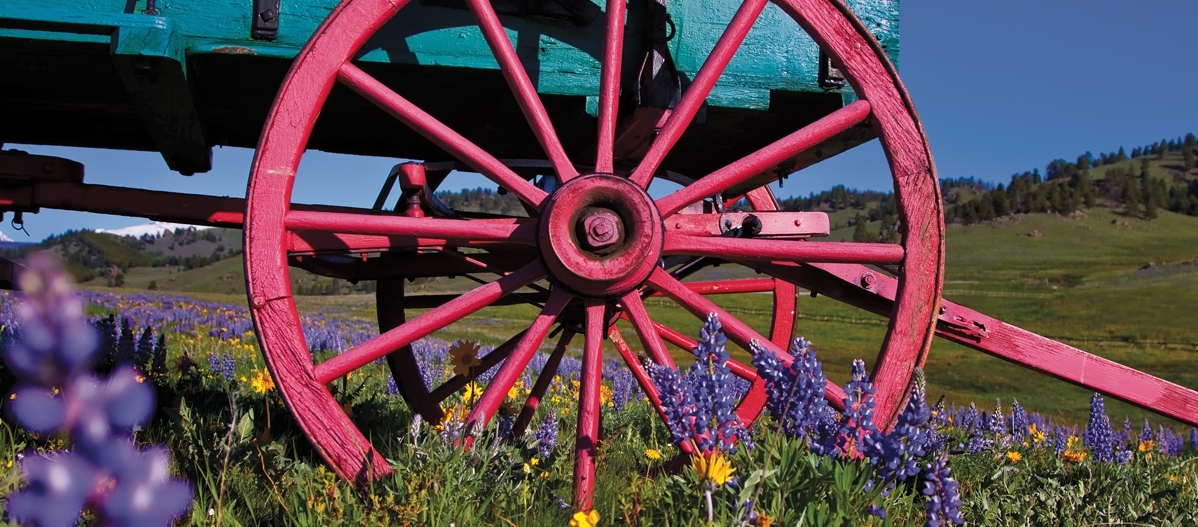One afternoon, not long after the man died, the mother and daughter drove up to the old sheep-wagon hill. They walked around, finding shards of glass, small pieces of metal, or shaped chips of wood that settled into the soil when, decades before, the sheep wagon was blown off its blocks to tumble over and over down the hill.
Now mother and daughter sat together on a big rock, facing west, to watch the sun go down over the high hills across the river. With sadness, the mother related sheep wagon stories.
In their early married years, the young couple lived in the sheep wagon out in the pasture for weeks or even months.
The triple-layered white canvas top, stretched tight onto the arched wooden ribs, made the wagon light and easy to move. Well-planned camping trailers of today have a striking resemblance to the sheep wagon, but this one was definitely not a recreation vehicle. The ends of the wagon were solid, made of boards cut different lengths to match the arch of the ribs. A small window in the back with a narrow windowed door at the front gave some ventilation.
Steps reached from ground to door, so they wouldn’t have to climb on the wagon tongue to enter the wagon. A bed platform crossed the wagon bed, tucked tight against the back wall, with a bench along each side with storage drawers underneath.
A pull-out table tucked itself under the bed platform, and a cast-iron wood-burning stove, about 2 feet square, squatted in the corner, right beside the door. The stovepipe stuck up through the canvas top.
The wagon sat on iron-clad wheels with rounds of large logs placed to support the corners.
The dirty white canvas was an anomaly in the otherwise yellow-tan of the dried grasses and became a landmark that could be seen for miles. With the help of a kerosene lamp, it glowed like a beacon through the dark nights, the light casting shadows on the canvas walls.
Before they could afford woven wire to fence in the sheep and fence out some of the predators, sleeping next to the bedding grounds was the best thing they could do. Coyotes, both the four-legged and two-legged rustler types, could quietly steal away a sheep or two. In this remote section of Southeastern Montana there was so little traffic, it was easy to tuck a lamb or sheep into the trunk and go on up the road—cheap eats if you’re not caught. Losing a sheep or two seemed to happen every year. But, if the couple was close, they could usually stop a coyote slaughter, or heavy rustling.
The sheep on this ranch were never coddled with much of a shelter, even during early spring lambing season. Birthing a lamb took place in the open pasture. Being nearer the sheep at this time assured that fewer lambs were lost, especially when the yearlings were having their first experience at lamb birth.
Several times every night, the couple would rouse themselves from the cozy sheep wagon bed, slip warm pants over their nightshirts and long underwear, don grungy overcoats, and go out with flashlights to check the sleeping sheep. Sometimes they had to help a ewe give birth. Sometimes they had to drive away, or shoot, prowling coyotes. Sometimes they just ventured out into the night with no particular excitement.
They paused for a moment to spend a quiet time before rejoining their sleeping daughter on the bed platform. Snuggling close on the wagon tongue, they gazed at the Milky Way or the quarter moon. He said you could tell if it would rain or snow if the moon arc was arranged such that precipitation might drip off the curve. Once, they waited, huddling close, excited, as the moon was eclipsed by the shadow of the earth.
The sheep naturally stayed close to each other at night in the bedding ground. No matter how far away they grazed, the sheep liked to go back to the same familiar place every night. The old ewes knew where this summer bedding ground was, in the swale between two higher rounded hills in the north pasture where the sheep wagon balanced on its log supports near the top of the hill to the north.
By the time their first daughter was old enough to walk, the sheep herd was growing, and they were slowly getting enough money for fence materials. Even so, the man often went off to work for a large rancher or some of the closer neighbors or to work on the new fence around the middle pasture.
Pregnant with their second child, the wife stayed with the sheep. As she walked around the herd and the little girl tired, the young mother carried her, either in her arms or on her shoulders. She often carried a 22-caliber rifle, too. She might get a good shot at a jack rabbit or a sage grouse. When they got back to the sheep wagon, the successful hunter built a fire in the little stove, cleaned whatever critter she had bagged, and started cooking their savory supper.
As the sun went down, the man rode his favorite sorrel horse, Old Red, up the hill. The smoke from the chimney told him supper was on. He could smell the biscuits, rising high and soft as they baked in the small oven. The aroma of fresh rabbit stew, made with potatoes, carrots, onions and canned tomatoes, filled the little sheep wagon, flew out the stove pipe and reinvigorated the man, tired from a long day’s work.
Now, this late evening, so many years later, the mother and youngest daughter watched the afterglow to the west, not wanting to break the spell of memory. With a sad smile, the mother told how her husband, now gone from his fourth and last heart attack, whooped as he jumped off Old Red. He tied the reins to the wagon wheel and took the first step up to the tiny open door where she nearly always waited for him.
“He wrapped his arms around my waist, stood on the step with his head buried in my big pregnant belly,” she sighed.
“He said the new baby there made him feel stronger. It was like we felt strong together. I just tossed his hat to the bench and leaned my cheek down on his sweaty head. Sometimes we just stood there for a while. We seemed to fit together better then.” MSN










